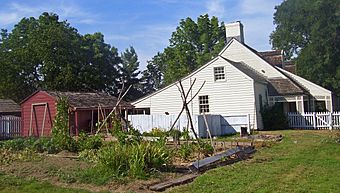Woodville (Heidelberg, Pennsylvania) facts for kids
|
Woodville
|
|

The south side of the house, showing the kitchen wing, garden, and other buildings in 2008.
|
|
| Nearest city | Heidelberg, Pennsylvania |
|---|---|
| Built | 1785 |
| Architect | John Neville |
| Architectural style | Colonial |
| NRHP reference No. | 74001733 |
Quick facts for kids Significant dates |
|
| Added to NRHP | February 5, 1974 |
| Designated NHL | July 28, 1983 |
Woodville, also known as the Neville House, is a historic home located near Heidelberg, Pennsylvania. It is famous because of its first owner, John Neville. He was a tax collector during an important event in American history called the Whiskey Rebellion.
The oldest part of the house was built around 1775. This makes Woodville one of the oldest houses in Allegheny County. It has been carefully restored to look like it did long ago. Because of its history, Woodville was named a National Historic Landmark in 1983. Today, it is a historic house museum that people can visit.
Contents
What Does Woodville Look Like?
The house sits on a one-acre piece of land. It is a one-and-a-half-story house made with a wooden frame. It has a sloped gable roof with four dormer windows and two brick chimneys.
A long porch, called a veranda, runs across the entire front of the house. A smaller, one-story kitchen wing is attached to the south side. Next to the kitchen, there is a small garden.
Inside, the house has a center-hall plan, which means a hallway runs through the middle of the house. A staircase in the hall leads to the upstairs bedrooms. The first floor has a large living room, a dining room, and another smaller room. The kitchen is in the wing. All the rooms have been filled with furniture and objects that look like they did in the 18th and 19th centuries.
The History of Woodville
The story of Woodville is connected to its owners and the history of the United States.
John Neville and the Early Years
John Neville was an important figure in the Pittsburgh area. He moved to the region from Virginia in 1774. The next year, he was put in command of Fort Pitt, which was located where downtown Pittsburgh is today.
Neville fought as an officer in the Continental Army during the Revolutionary War. He retired in 1783 as a brigadier general. Around 1785, he built the main part of the Woodville house. He also built another, larger home nearby called Bower Hill. He let his son, Presley Neville, live at Woodville.
The Whiskey Rebellion
In the 1790s, the U.S. government needed to pay off debts from the Revolutionary War. The government, led by President George Washington, decided to place a tax on whiskey. This is called an excise tax. John Neville was appointed as the tax collector for western Pennsylvania.
This tax was very unpopular with local farmers. For them, turning their grain into whiskey was the easiest way to get it to market. Many farmers refused to pay the tax. This protest grew into what is now known as the Whiskey Rebellion.
In 1794, a group of angry farmers marched to Neville's home. Neville and his household were able to defend Woodville. However, the protestors later burned down his other home, Bower Hill. The rebellion became so serious that President Washington sent the army to stop it. This was the first major test of the new U.S. government's power.
Changes Through the Centuries
After the rebellion, John Neville's family continued to own Woodville. In 1814, the house was sold to a banker named Stephen Barlow. Two years later, he sold it to Christopher Cowan for a profit.
Cowan made many changes to the house. He connected the kitchen to the main house and added the front porch. He also painted the house white. His family, the Cowans, lived in the house for nearly 150 years. Over time, they made other changes, like painting the house different colors and adding new decorations.
In 1975, the last of the Cowan family moved out. The house was given to the Pittsburgh History and Landmarks Foundation. The foundation turned Woodville into a museum for the public to enjoy.
Woodville Today
Today, Woodville is managed by a group called Neville House Associates. They have worked to restore the house to its early 19th-century appearance, including painting it white again.
The house is a popular historic site and a stop on the American Whiskey Trail, a tour of places important to the history of American whiskey. Visiting Woodville is like taking a step back in time to the early days of the United States.
See also




